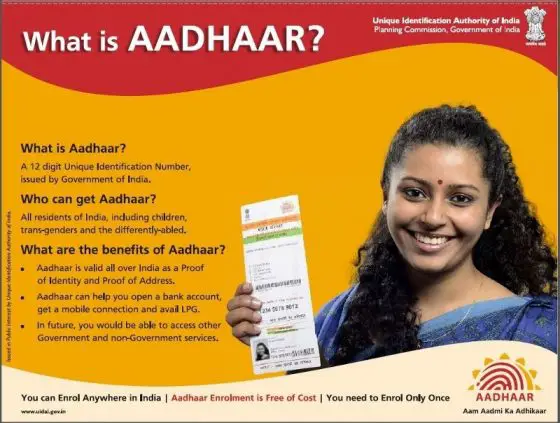Introduction:-
- The idea behind the unique identification number was to assign each individual a unique 12 digit number which will help to identify the individual uniquely.
- The objective was to attach all the biometric and demographic data of an individual with a 12-digit unique identity number called Aadhaar. The biometric and demographic data of individual will be stored in a centralized database.
- The act related to Aadhaar was initially introduced as a money bill in the parliament of India on 3rd March 2016.
- The bill was passed in the Lok Sabha on 11th March 2016 and on 26th March 2016, this bill became an Act.
- The process of issuing the unique number and collection, maintenance and updating of biometric and demographic data related to each individual is done by the ‘Unique Identification Authority of India (UIDAI)‘, which is a central government agency of India.
- With the issuance of Aadhaar card, India has entered the group of countries which has national identity cards for its native residents.
- Even though Aadhaar was initially started to eliminate leakages, with time it became a basic identity document.
Reasons for this move:-
- This process of attaching all the legal data of an individual with a unique number is an attempt of India to develop a secure system of identification and will have a long term impact.
- The first recommendation of any such identity number was after the 1999 Kargil war by the Kargil Review Committee to then Prime Minister of India, for the security and authenticity reasons.
- With the centralized database of each individual, it became possible for security agencies to access information of each citizen under a certain emergency situation in the interest of the national cause.
- By considering the population of India, it was necessary to have such a secure identification system for controlling illegal migration and anti-national activities.
In Favor:-
- By connecting the Aadhaar number with the banking system, the Indian government has created a proper and secure channel through which beneficiaries receive all the subsidies directly to their bank account.
- It has eliminated the role of middleman and agents thus helping the poor and the Indian Economy. Thereby Aadhaar empowers marginalised sections and ensures dignity.
- With the help of UID, it became possible to identify the native Indians and illegal migrants and thus helps to ensure that only the Indian citizens and the legal migrants get benefits of government schemes and also employment.
- As all the biometric and demographic data of an individual is linked to Aadhaar, it helps to identify the families that really belongs to BPL (Below Poverty Level) and hence providing them employment under NREGA (National Rural Employment Guarantee Act) and also easy and prompt payment to the actual workers.
- Another big issue which can be addressed through UID is the real number of voters. Rural to urban migration is highly prevalent in India. Thus they enrol their names in the voter list of both places and politicians take an ill advantage of such a situation. But by the implementation of UID, it will not be possible for any individual to possess more than one voter identity card.
- Government of India could save 15000 crores till 2016 by linking bank accounts with aadhaar for the LPG cylinder subsidies. Aadhaar will eliminate fake accounts.
- Aadhaar based biometric attendance will make a good impact in government offices where most people try to escape from their work.
- UID will also help indirectly in controlling corruption.
Challenges:-
- For a nation like India with such a large population, it becomes a matter of security risk to handle such a large data of individual associated with their UID.
- As almost all the details are associated with Aadhaar, it poses a threat to ‘right to privacy’. The data is susceptible to commercial exploitation by private parties and also to surveillance by the government.
- No effective implementation of law and punishments in case of any misuse such as the leakage of personal information of citizens.
- Assigning UID to such a huge population with authenticity is also a big challenge as no prior documents asked for it.
Conclusion:-
UID for every Indian is a very good system for eliminating agents and commission culture from India. It will help the poor to get their benefits directly to their accounts. It will also help in eliminating the illegal migrants from India and thus controlling the anti-national activities. But the implementation and execution must be done in a proper and prompt manner. And there must some guidelines related to risks associated with the system.
Your Turn… What are your thoughts on this topic? Express your opinion in the comment section below. And subscribe to our blog to read answers to the trending GD topics.
Copyright @ Group Discussion Ideas.

